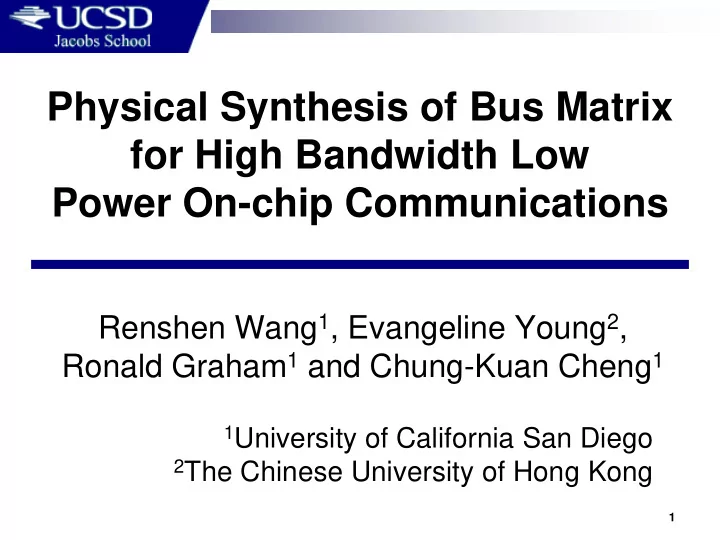

Physical Synthesis of Bus Matrix for High Bandwidth Low Power On-chip Communications Renshen Wang 1 , Evangeline Young 2 , Ronald Graham 1 and Chung-Kuan Cheng 1 1 University of California San Diego 2 The Chinese University of Hong Kong 1
Outline of This Talk Trends of on-chip communications Bandwidth requirement Bus bus matrix, network-on-chip Power consumption Low power design techniques Optimizations and tradeoffs in physical synthesis of bus matrix Bus gating on Steiner graph (power) Weighted Steiner graph (bandwidth) Edge merging heuristic (wire length) 2
Introduction Importance of low power Heat removal, battery life, performance, electricity, envioronment… NVIDIA Tegra chip SoC communication power increasing Advances in manufacturing process more components ( n ) higher throughput ( n 1.xx? ) Long wires (global on-chip interconnect) relatively scaling up on power Goal: power efficiency on data throughput Simple bus power efficient bus 3
Bus vs. NoC Bus / Bus matrix and Network-on-chip comparisons Bus NoC Bus gating Packet, routing Power Latency Bus matrix Flexibility Bandwidth 4
Bus Matrix Overview Buses allowing multiple transactions AMBA AHB/AXI protocols, etc Example: a full (high bandwidth) bus matrix Power efficient, but not wire efficient Matrix Arbiter Decoder Mux/ S1 de- Mux/ M1 mux de- mux Arbiter Mux/ S2 de- mux Decoder Arbiter Mux/ M2 de- Mux/ mux S3 de- mux 5
Problem Formulations Communication constraint graph Bipartite graph G = ( U , W , A ) U : set of masters W : set of slaves A: set of arcs, arc ( u , w ) means u accesses w Given a placement and a communication constraint graph G , find a bus matrix with Bandwidth capability for G Each component can have at most 1 connection at a time Minimal power on data (path length) Minimal wires 6
Ideal Bus Matrix Definition 1: Given G = ( U , W , A ) and placement function P : U ∪ W R 2 , an ideal bus matrix graph is a weighted graph Θ = ( V , E , ω ) that Computationally expensive No common vertex Path is shortest Minimize 7
Practical Formulation Definition 2: Given G = ( U , W , A ) and placement function P : U ∪ W R 2 , a bus matrix graph is a weighted graph H = ( V , E , ω ) with a set of paths ρ : A Π that With fixed paths, no real- time computation needed Path is shortest No common vertex Minimize 8
Constructing a Solution Communication & placement are given Number of paths fixed Path length fixed (Manhattan distance) u 3 u 3 w 2 w 3 w 2 w 3 u 1 u 1 v 0 u 2 u 2 w 1 w 1 Generate a structure for min wire length 9
Graph Construction Algorithm 1. Generate a shortest-path w 2 u 3 w 3 Steiner graph u 1 v 0 Algorithm from “ Low Power Gated Bus Synthesis using Shortest-Path w 1 u 2 Steiner Graph for System-on-Chip Communications ” DAC 2009 2. Pick a shortest path for each arc ( u i , w j ) in A Randomly pick one if multiple shortest paths exist, to distribute the “load” evenly on graph edges 3. Compute edge weight for each edge in the Steiner graph 10
Minimum Rectilinear Steiner Arborescence (MRSA) Steiner tree w/ shortest root-to-leaf paths Constructed by merging sub-trees with the furthest merging point from the root “ Efficient algorithms for the minimum shortest path Steiner arborescence problem …” by Cong, Kahng & Leung. IEEE TCAD 1998 11
Shortest-path Steiner Graph Multiple MRSA constructions Each master device as a root 1 st MRSA From the 2 nd MRSA, wires can be shared s 2 New source s 1 Steiner point in T’ Terminal in T’ 12
Edge Weight by Max-Matching To allow multiple u 3 u 3 w 2 w 2 w 3 w 3 transactions/paths, u 1 u 1 v 0 v 0 add edge weight u 2 u 2 (multiple bus lines) w 1 w 1 13
Reducing Wire Length High bandwidth+short paths more wires Loosen the shortest-path constraint E.g. (1+ ε ) Manhattan distance Merge parallel edges reduce wires Low increase on path length / dynamic power 14
Parallel Segment Merging Iteratively, find parallel double segments Δ l – edge length (not wire length) reduction Δ p – possible path length increase Merge the pair with maximum Δ l / Δ p 15
Overall Flow Low complexity in each iteration Most time consumed by max-matching O(|U+W||A||E|) 16
Experimental Results Same random cases as in [Wang09] Maximum bandwidth guaranteed Min-power bus matrix (w/o segment merging) Min-wire bus matrix 17
Experimental Results (cont.) Min-power to Min-wire, on average Total wire length reduced by 15.5% Average path length increased by 4.4% 18
Experimental Results (cont.) Total wire length vs. total edge length along parallel segment merging operations First decreasing (less edges) Then increasing (longer paths) 19
Experimental Results (cont.) Tradeoff between wire & power Tradeoff between wire & bandwidth 20
Conclusions On chip bus matrix can be strong at Performance Small delay (by centralized arbitration & control) Consistent bandwidth Efficiency on power (shortest connections) on wire (sharing bus lines in Steiner graphs) More possibilities Architectures (AMBA AHB, CoreConnect…) Communication patterns 21
Questions & Answers Thank you for your attention! 22
Recommend
More recommend